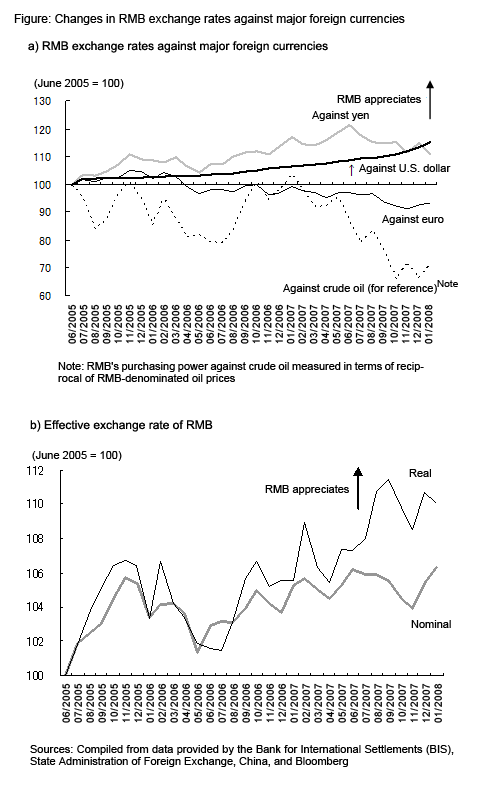Reflecting a rise in the RMB's real exchange rate
In China, inflation is proceeding concurrently with the rise of the renminbi (RMB) against the U.S. dollar, and the fall of the internal value of the Chinese currency is contrasting sharply with the rise of its external value (figure 1). This means that purchasing power parity (PPP) does not hold and the RMB's real exchange rate (RER) is rising.
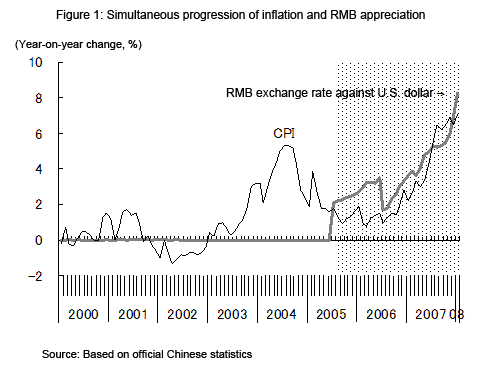
According to the purchasing power parity hypothesis, a country's currency weakens when its inflation is high relative to other countries. A decrease in the currency's internal value leads to a decrease in its external value by way of a weakening exchange rate. When the level of overseas prices is given, the currency's exchange rate (external value of the currency) is lowered to a level corresponding to the rise in domestic prices (decrease in the internal value of the currency), or raised to correspond to the decrease in domestic prices (increase in the internal value of the currency). The internal and external values of a currency thus move in the same direction and in proportion to each other when purchasing power parity holds. As a result, the real exchange rate of the currency (the ratio of domestic prices to foreign prices measured in terms of the same currency unit, or the value of domestic products relative to foreign products) is kept at a constant level (note 1).
In contrast, the simultaneous progression of inflation and RMB appreciation currently observed in China indicates that purchasing power parity does not hold and the real exchange rate of the RMB has been rising (box 1). Inflation means an increase in the general level of prices of Chinese products, while RMB appreciation lowers the prices of foreign products in terms of RMB (box 2). In reflection of these factors, the prices of Chinese products relative to foreign ones, that is, the real exchange rate of the RMB, have been rising.
Factors behind the rise in real exchange rate
The rise in the real exchange rate of the RMB is seen as evidence of increased international competitiveness of Chinese products on one hand, and fast productivity growth in the tradable good sector that puts upward pressure on the general price level as the Chinese economy approaches the "full employment" level in the course of economic development (the so-called "Balassa-Samuelson effect") on the other.
First, reflecting changes in the international market, China's relative price of exports compared to its imports (trade partners' exports) has increased (i.e., China's terms of trade have improved). Until recently, Chinese-made products had not been competitive in the international market, often labeled as cheap and low-quality, and the only way for China to expand exports was lowering prices by devaluing the currency. Thus, the exchange rate of the RMB had steadily declined along with deteriorating terms of trade. More recently, however, as Chinese products become more competitive in the international market, the RMB has been coming under upward pressure and started to appreciate.
Furthermore, even where the law of one price, a basis of the purchasing power parity theory, holds true for tradables such as goods, this is not necessarily true for non-tradables such as services. Especially in high-growth countries, the prices of non-tradables tend to rise relative to tradables. This phenomenon was expounded on by two economists, B. Balassa and P. A. Samuelson, in the 1960s. They noted that wages in the tradable sector with a high rate of productivity growth (manufacturing sector) rise in proportion to the growth in productivity and wages in the non-tradable sector with a low rate of productivity growth (service sector) also rise at a rate almost equal to that for tradable sectors since wages tend to be equalized across sectors due to labor mobility. The wage increase in the tradable sector, which matches the growth in productivity, does not result in increased prices. However, the wage increase in the non-tradable sector, which exceeds the growth in productivity, pushes up prices. The result is an increase in prices of non-tradables relative to those of tradables. Provided that the prices of tradables (in terms of a foreign currency, as applicable) are given, changes in relative prices cause an increase in prices of non-tradables (services), eventually leading to an increased overall price level (weighted average of prices of tradables and non-tradables) under the fixed exchange rate regime, and a rise in the exchange rate under the floating exchange rate regime, where the primary goal is to maintain price stability. In either case, the real exchange rate increases (figure 2).
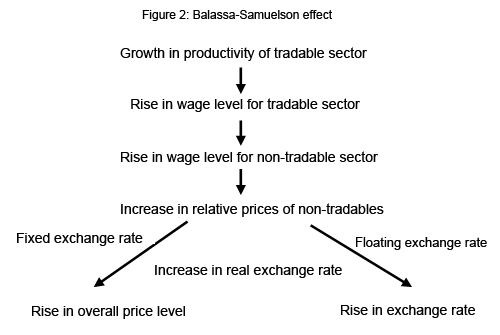
Until recently, the "Balassa-Samuelson effect" has not been observed in China because productivity growth was not translated into increased wages a great deal due to an enormous labor surplus. However, the impact of productivity growth is finally becoming obvious now that China is shifting from labor surplus to shortage amid robust performance of the economy and the massive labor migration from rural to urban areas.
In addition to a rising equilibrium rate attributable to changes in these fundamentals, the exchange rate adjustment to the equilibrium is also reflected in the ongoing rise of the RMB's real exchange rate. The nominal exchange rate of the RMB has been kept artificially low through central bank intervention (figure 3). With its currency undervalued, China is running a huge external surplus. Simultaneous progression of inflation and RMB appreciation (decrease in internal value and increase in external value of the RMB) would contribute, through a rise in the RMB's real exchange rate, to correcting China's external imbalance
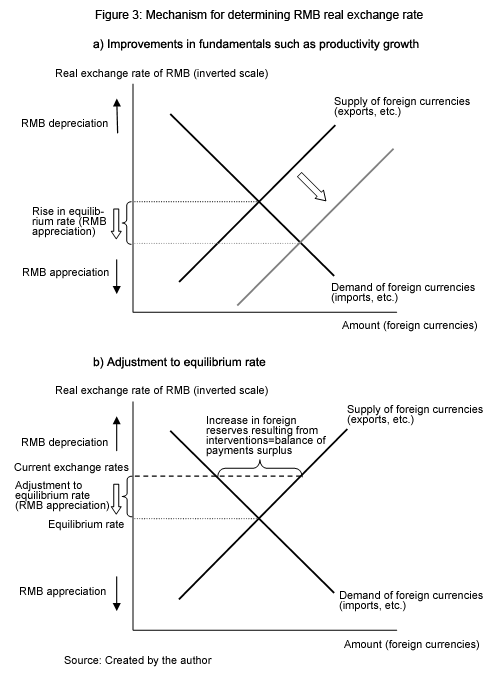
Box 1: Changes in real exchange rate as a precondition for the divergence between the internal and external values of the RMB
Real exchange rate is the ratio of domestic prices to foreign prices measured in the same currency. When domestic products are not equal in quality to foreign products, the real exchange rate, which is the relative price of the products, fluctuates in accordance with changes in supply and demand.
Where p is the domestic price level (domestic product prices in domestic currency) and e is the (nominal) exchange rate (measured in terms of units of foreign currency per unit of domestic currency so that its rises as the domestic currency appreciates), and p* is the foreign price level (foreign product prices in foreign currencies), the real exchange rate (t) is described as:
![]()
As shown in the above equation, the real exchange rate increases with an increase in the domestic price level and the (nominal) exchange rate, and decreases with an increase in the foreign price level. If no distinction is made between tradables and non-tradables, and provided that a country specializes in the production of a single product as do foreign countries, the domestic price level is equal to the country's export price and the foreign price level is equal to the import price, with the real exchange rate equal to the relative price of exports against imports, hence, synonymous with the terms of trade. Whereas the nominal exchange rate is the ratio of exchange between currencies, the real exchange rate is the ratio of exchange between products.
As shown below, the relationship between the domestic price level (internal value of domestic currency) and foreign price level (external value of domestic currency) is greatly affected by changes in the real exchange rate (figure).
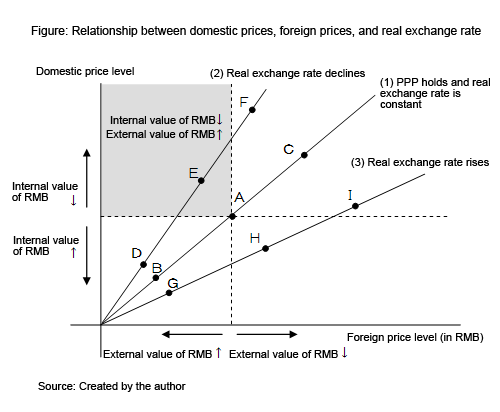
(1) Where the real exchange rate is constant (PPP holds), the domestic price level and foreign price level always move in proportion to each other. Starting from point A, only two patterns of movement are possible: the point can be moved in the direction of B in which "the RMB rises in both internal and external values" or in the direction of C in which "the RMB declines in both internal and external values."
(2) Where the real exchange rate goes up, point D represents where "the RMB rises in both internal and external values" and point F where "the RMB falls in both internal and external values," compared to the initial situation represented by A as the starting point. Point E is the actual, current case, wherein "the RMB declines in internal value but rises in external value." Thus a rise in the real exchange rate is a necessary but not sufficient condition for decreasing internal value and increasing external value of the RMB.
(3) Where the real exchange rate goes down and provided that point A is the starting point, point G represents where "the RMB rises in both internal and external values" and point I where "the RMB falls in both internal and external values," whereas point H represents where "the RMB rises in internal value but falls in external value." A case wherein "the RMB declines in internal value but rises in external value" cannot occur.
Box 2: Factors affecting external value of RMB (other than exchange rate against U.S. dollar)
The external value of the RMB depends not only on its exchange rate against the U.S. dollar but also on its exchange rate against the currencies of other trade partners, as well as on overseas price movements (Figure). Since July 2005, when China shifted to a managed floating exchange rate regime, the RMB has appreciated against the U.S. dollar and the yen at about the same rate, but depreciated against the euro. As a result, the (nominal) effective exchange rate of the RMB against major foreign currencies, which reflects the relative weight of each of China's major trade partners, has not increased as much as against the U.S. dollar. Meanwhile, rises in foreign prices have been serving to reduce the external value of the RMB. In particular, higher prices of oil and many other primary commodities, for which China must rely on imports, have been offsetting part of the rise in the external value of the RMB resulting from the RMB's appreciation. The combination of these factors suggests that the rise in external value of the RMB remains modest relative to the rise in its exchange rate against the U.S. dollar. However, reflecting the higher inflation rate in China than overseas, the real effective exchange rate of the RMB has been showing a sharper increase than the nominal effective exchange rate (according to BIS statistics).
